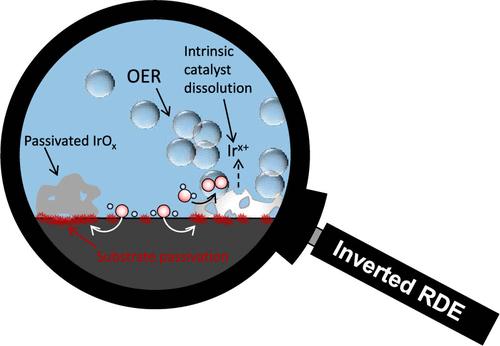当前位置:
X-MOL 学术
›
ACS Catal.
›
论文详情
Our official English website, www.x-mol.net, welcomes your
feedback! (Note: you will need to create a separate account there.)
Disentangling the Pitfalls of Rotating Disk Electrode-Based OER Stability Assessment: Bubble Blockage or Substrate Passivation?
ACS Catalysis ( IF 11.3 ) Pub Date : 2024-11-13 , DOI: 10.1021/acscatal.4c05447 Aline Bornet, Pavel Moreno-García, Abhijit Dutta, Ying Kong, Mike Liechti, Soma Vesztergom, Matthias Arenz, Peter Broekmann
ACS Catalysis ( IF 11.3 ) Pub Date : 2024-11-13 , DOI: 10.1021/acscatal.4c05447 Aline Bornet, Pavel Moreno-García, Abhijit Dutta, Ying Kong, Mike Liechti, Soma Vesztergom, Matthias Arenz, Peter Broekmann

|
Oxygen evolution reaction (OER) catalyst stability metrics derived from aqueous model systems (AMSs) prove valuable only if they are transferable to technical membrane electrode assembly (MEA) settings. Currently, there is consensus that stability data derived from ubiquitous rotating disk electrode (RDE)-based investigations substantially overestimate material degradation mainly due to the nonideal inertness of catalyst-backing electrode materials as well as bubble shielding of the catalyst by evolved oxygen. Despite the independently developed understanding of these two processes, their interplay and relative impact on intrinsic and operational material stability have not yet been established. Herein, we employ an inverted RDE-based approach coupled with online gas chromatographic quantification that exploits buoyancy and anode hydrophilicity existing under operating acidic OER conditions and excludes the influence of bubble retention on the surface of the catalyst. This approach thus allows us to dissect the degradation process occurring during the RDE-based OER stability studies. We demonstrate that the stability discrepancy between galvanostatic nanoparticle (NP)-based RDE and MEA data does not originate from the accumulation of bubbles in the catalyst layer during water oxidation but from the utilization of corrosion-prone substrate materials in the AMS. Moreover, we provide mechanistic insights into the degradation process and devise experimental measures to mitigate or circumvent RDE-related limitations when the technique is to be applied to an OER catalyst stability assessment. These findings should facilitate the transferability between AMS and MEA approaches and promote further development of the latter.
中文翻译:

解开基于旋转圆盘电极的 OER 稳定性评估的陷阱:气泡堵塞还是基材钝化?
从水性模型系统 (AMS) 得出的析氧反应 (OER) 催化剂稳定性指标只有在可转移到技术膜电极组件 (MEA) 设置时才能证明其价值。目前,人们一致认为,来自无处不在的基于旋转圆盘电极 (RDE) 的研究得出的稳定性数据大大高估了材料降解,这主要是由于催化剂背衬电极材料的非理想惰性以及析出氧对催化剂的气泡屏蔽。尽管对这两个过程有独立的理解,但它们的相互作用和对内在和操作材料稳定性的相对影响尚未确定。在此,我们采用一种基于倒置 RDE 的方法与在线气相色谱定量相结合,利用在操作酸性 OER 条件下存在的浮力和阳极亲水性,并排除气泡滞留对催化剂表面的影响。因此,这种方法使我们能够剖析基于 RDE 的 OER 稳定性研究期间发生的降解过程。我们证明,基于恒电流纳米颗粒 (NP) 的 RDE 和 MEA 数据之间的稳定性差异不是源于水氧化过程中催化剂层中气泡的积累,而是源于 AMS 中易腐蚀基材的利用。此外,我们提供了对降解过程的机理见解,并设计了实验措施,以减轻或规避该技术应用于 OER 催化剂稳定性评估时与 RDE 相关的限制。这些发现应促进 AMS 和 MEA 方法之间的可转移性,并促进后者的进一步发展。
更新日期:2024-11-13
中文翻译:

解开基于旋转圆盘电极的 OER 稳定性评估的陷阱:气泡堵塞还是基材钝化?
从水性模型系统 (AMS) 得出的析氧反应 (OER) 催化剂稳定性指标只有在可转移到技术膜电极组件 (MEA) 设置时才能证明其价值。目前,人们一致认为,来自无处不在的基于旋转圆盘电极 (RDE) 的研究得出的稳定性数据大大高估了材料降解,这主要是由于催化剂背衬电极材料的非理想惰性以及析出氧对催化剂的气泡屏蔽。尽管对这两个过程有独立的理解,但它们的相互作用和对内在和操作材料稳定性的相对影响尚未确定。在此,我们采用一种基于倒置 RDE 的方法与在线气相色谱定量相结合,利用在操作酸性 OER 条件下存在的浮力和阳极亲水性,并排除气泡滞留对催化剂表面的影响。因此,这种方法使我们能够剖析基于 RDE 的 OER 稳定性研究期间发生的降解过程。我们证明,基于恒电流纳米颗粒 (NP) 的 RDE 和 MEA 数据之间的稳定性差异不是源于水氧化过程中催化剂层中气泡的积累,而是源于 AMS 中易腐蚀基材的利用。此外,我们提供了对降解过程的机理见解,并设计了实验措施,以减轻或规避该技术应用于 OER 催化剂稳定性评估时与 RDE 相关的限制。这些发现应促进 AMS 和 MEA 方法之间的可转移性,并促进后者的进一步发展。































 京公网安备 11010802027423号
京公网安备 11010802027423号